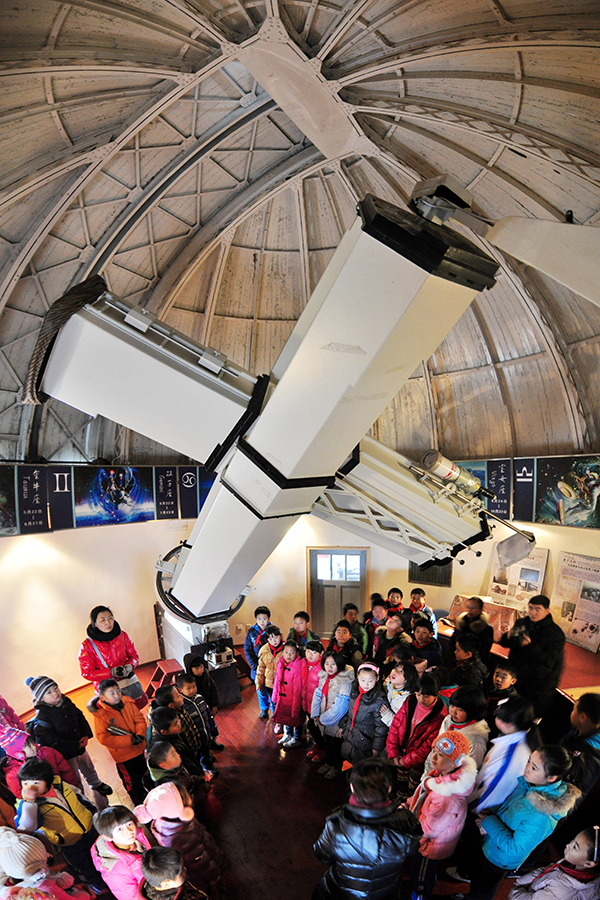The nation's great changes as seen through a telescope


Founded in 1934, the Purple Mountain Observatory-China's first modern observatory, which evolved from the former Institute of Astronomy-changed its name to the PMO of the Chinese Academy of Sciences in 1950.
Its earliest astronomical instruments, still well preserved on the picturesque peak of the Purple Mountain in Nanjing, Jiangsu province, are now mainly used to promote science and attract many visitors every year.
Despite being named after the Purple Mountain, its observation stations are distributed widely-from eastern China's Shandong province to Qinghai in the northwest, and from northeastern China's Heilongjiang to Yunnan province in the southwest-and even as far as Antarctica.
The observatory has become an influential institution in daily life. Every day, it provides the exact time the sun will rise and set, and helps to establish the right time to raise the national flag in Beijing's Tian'anmen Square. It measures the 24 solar terms (the seasonal division points in the Chinese lunar calendar) and compiles the nautical almanac to guide Chinese ships that sail the globe.
Its astronomers have intensified the monitoring of space debris.
"We can provide an accurate early warning of falling space debris," says Zhan Jinwei, an assistant researcher at the PMO's department of applied astromechanics and space debris.
It also provides collision-avoidance advice for the growing numbers of Chinese spacecraft.
Facility advancement
All of this is only made possible with advanced observatory equipment, which was rarely available to previous generations of Chinese astronomers.
The International Astronomical Union invited China to join the measurement of Earth's longitude and latitude in the 1930s, but Chinese astronomers failed to participate as they were unable to prepare the instruments in time. Chinese astronomers managed to raise money to buy a telescope from the United States in order to observe the total solar eclipse in 1941, but it was destroyed by Japanese aircraft after it was shipped to Hong Kong.
The biggest change, however, was brought about by the reform and opening-up since 1978. At that time, China's economic aggregate accounted for less than 2 percent of the world's total, compared with 15 percent today.
Now, the PMO has developed an advanced satellite, the Dark Matter Particle Explorer, or DAMPE, with cooperation from other research institutes and universities and an investment of about 700 million yuan ($103 million).
Construction has also begun on a second satellite designed to study the sun that's expected to be launched in 2022.
The PMO, together with other organizations, is also pushing forward with construction of an observatory in Antarctica with an estimated investment of 1 billion yuan.
Sky's the limit
Chinese astronomers today do many things their predecessors could only dream of.
During wartime in the 1940s, the PMO was moved to Yunnan province, and it was impossible for the astronomers to conduct any observations. They could only study old data and achieved limited results.
"We are now carrying out a project to paint a portrait of the Milky Way, using a millimeter-wave telescope in Delingha, Qinghai province," says Mao Ruiqing, the PMO's deputy director. "We aim to probe the distribution, structure and physical properties of molecular clouds to get a relatively complete picture of the structure of the Milky Way."
So far, he says, nearly 70 percent of the ambitious project is complete.
Chen Dengyi, 30, is working on the detector of the second-generation dark-matter satellite in the new PMO laboratory. When China's first DAMPE satellite was launched in 2015, Chen was monitoring the data at the Jiuquan Satellite Launch Center. He says: "I cried with excitement when I heard that the satellite's solar panels had unfolded successfully."
Fan Yizhong, deputy chief engineer of the application system of DAMPE, was born in a rural area in 1977. He would not have gone to college without the financial support of his brother, who went to work in Shenzhen, the city at the vanguard of the reform and opening-up.
Fan first majored in engineering, but he later decided to follow his interest and went to Nanjing University to study astronomy. "I was influenced by Stephen Hawking."
Wu Xuefeng, deputy dean of the PMO's academy of astronomy and space science, says: "How was the universe born? Why does intelligent life exist? Are there other universes? Chinese people also want to answer these questions."
The Chinese telescopes on the Antarctic ice sheet might help in that endeavor. Two survey telescopes have been installed at an automatic observation station at Dome A since 2007 with a third planned for 2019.
With these telescopes, Chinese astronomers have received optical signals relevant to the gravitational waves generated by the merging of two neutron stars, which was discovered for the first time in 2017. They have also found more than 100 candidates for extrasolar planets.
All in one
"Openness and cooperation are important for astronomy research," says Shi Shengcai, director of PMO's department of Antarctic and radio astronomy.
The PMO joined the International Asteroid Warning Network under the United Nations Committee on the Peaceful Uses of Outer Space in 2018.
Astronomers have used a PMO telescope in Xuyi, Jiangsu province, to search for near-Earth asteroids since 2006.
"An early-warning system for near-Earth asteroids that pose potential threats is one of the contributions made by the PMO to the shared future of humanity," says Ji Jianghui, a researcher at the PMO's department of planetary science and deep-space exploration.
"Since 2000, about a third of our students have been able to study abroad. Astronomers from other countries came to our observatory to conduct joint research, too," says Wu.The nation's great changes as seen through a telescope
BEIJING-Founded in 1934, the Purple Mountain Observatory-China's first modern observatory, which evolved from the former Institute of Astronomy-changed its name to the PMO of the Chinese Academy of Sciences in 1950.
Its earliest astronomical instruments, still well preserved on the picturesque peak of the Purple Mountain in Nanjing, Jiangsu province, are now mainly used to promote science and attract many visitors every year.
Despite being named after the Purple Mountain, its observation stations are distributed widely-from eastern China's Shandong province to Qinghai in the northwest, and from northeastern China's Heilongjiang to Yunnan province in the southwest-and even as far as Antarctica.
The observatory has become an influential institution in daily life. Every day, it provides the exact time the sun will rise and set, and helps to establish the right time to raise the national flag in Beijing's Tian'anmen Square. It measures the 24 solar terms (the seasonal division points in the Chinese lunar calendar) and compiles the nautical almanac to guide Chinese ships that sail the globe.
Its astronomers have intensified the monitoring of space debris.
"We can provide an accurate early warning of falling space debris," says Zhan Jinwei, an assistant researcher at the PMO's department of applied astromechanics and space debris.
It also provides collision-avoidance advice for the growing numbers of Chinese spacecraft.
Facility advancement
All of this is only made possible with advanced observatory equipment, which was rarely available to previous generations of Chinese astronomers.
The International Astronomical Union invited China to join the measurement of Earth's longitude and latitude in the 1930s, but Chinese astronomers failed to participate as they were unable to prepare the instruments in time. Chinese astronomers managed to raise money to buy a telescope from the United States in order to observe the total solar eclipse in 1941, but it was destroyed by Japanese aircraft after it was shipped to Hong Kong.
The biggest change, however, was brought about by the reform and opening-up since 1978. At that time, China's economic aggregate accounted for less than 2 percent of the world's total, compared with 15 percent today.
Now, the PMO has developed an advanced satellite, the Dark Matter Particle Explorer, or DAMPE, with cooperation from other research institutes and universities and an investment of about 700 million yuan ($103 million).
Construction has also begun on a second satellite designed to study the sun that's expected to be launched in 2022.
The PMO, together with other organizations, is also pushing forward with construction of an observatory in Antarctica with an estimated investment of 1 billion yuan.
Sky's the limit
Chinese astronomers today do many things their predecessors could only dream of.
During wartime in the 1940s, the PMO was moved to Yunnan province, and it was impossible for the astronomers to conduct any observations. They could only study old data and achieved limited results.
"We are now carrying out a project to paint a portrait of the Milky Way, using a millimeter-wave telescope in Delingha, Qinghai province," says Mao Ruiqing, the PMO's deputy director. "We aim to probe the distribution, structure and physical properties of molecular clouds to get a relatively complete picture of the structure of the Milky Way."
So far, he says, nearly 70 percent of the ambitious project is complete.
Chen Dengyi, 30, is working on the detector of the second-generation dark-matter satellite in the new PMO laboratory. When China's first DAMPE satellite was launched in 2015, Chen was monitoring the data at the Jiuquan Satellite Launch Center. He says: "I cried with excitement when I heard that the satellite's solar panels had unfolded successfully."
Fan Yizhong, deputy chief engineer of the application system of DAMPE, was born in a rural area in 1977. He would not have gone to college without the financial support of his brother, who went to work in Shenzhen, the city at the vanguard of the reform and opening-up.
Fan first majored in engineering, but he later decided to follow his interest and went to Nanjing University to study astronomy. "I was influenced by Stephen Hawking."
Wu Xuefeng, deputy dean of the PMO's academy of astronomy and space science, says: "How was the universe born? Why does intelligent life exist? Are there other universes? Chinese people also want to answer these questions."
The Chinese telescopes on the Antarctic ice sheet might help in that endeavor. Two survey telescopes have been installed at an automatic observation station at Dome A since 2007 with a third planned for 2019.
With these telescopes, Chinese astronomers have received optical signals relevant to the gravitational waves generated by the merging of two neutron stars, which was discovered for the first time in 2017. They have also found more than 100 candidates for extrasolar planets.
All in one
"Openness and cooperation are important for astronomy research," says Shi Shengcai, director of PMO's department of Antarctic and radio astronomy.
The PMO joined the International Asteroid Warning Network under the United Nations Committee on the Peaceful Uses of Outer Space in 2018.
Astronomers have used a PMO telescope in Xuyi, Jiangsu province, to search for near-Earth asteroids since 2006.
"An early-warning system for near-Earth asteroids that pose potential threats is one of the contributions made by the PMO to the shared future of humanity," says Ji Jianghui, a researcher at the PMO's department of planetary science and deep-space exploration.
"Since 2000, about a third of our students have been able to study abroad. Astronomers from other countries came to our observatory to conduct joint research, too," says Wu.




































